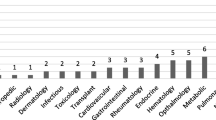Abstract
There are nearly 30 million Americans that suffer from at least one of the more than 7000 rare diseases identified to date. Therapies for treating, preventing, or diagnosing rare diseases have been limited due to various reasons. Incentives are provided to sponsors in an effort to promote the development of therapies for rare diseases and to encourage the availability of therapeutically superior drugs or biologics. This paper will discuss the mission of the Office of Orphan Products Development within the Food and Drug Administration (FDA), the specific programs within the office and the relation to incentives provided, achievements of the programs, and continued challenges in rare disease product development.


Similar content being viewed by others
References
NIH. National Center for Advancing Translational Sciences. Genetic and Rare Diseases Information center (2018) FAQs about rare diseases. https://rarediseases.info.nih.gov/diseases/pages/31/faqs-about-rare-diseases. Accessed 31 Oct 2018
Food and Drug Administration (2018) Orphan drug act—relevant excerpts. https://www.fda.gov/ForIndustry/DevelopingProductsforRareDiseasesConditions/HowtoapplyforOrphanProductDesignation/ucm364750.htm. Accessed 31 Oct 2018
Food and Drug Administration (2018) Orphan drug regulations, 56 Fed. Reg, pp 3338–3351. https://www.fda.gov/downloads/forindustry/developingproductsforrarediseasesconditions/ucm351283.pdf. Accessed 31 Oct 2018
Clarification of orphan designation of drugs and biologics for pediatric subpopulations of common diseases. Guidance for industry. https://www.fda.gov/downloads/RegulatoryInformation/Guidances/UCM589710.pdf. Accessed 12 Apr 2018
Imoisili MA, Mueller C, Needleman K (2014) Fueling the development of products for rare diseases: the impact of the FDA’s orphan products grants program. Expert Opin Orphan Drugs 2(8):1–9
Rare diseases: common issues in drug development. Guidance for industry. Draft guidance. https://www.fda.gov/ucm/groups/fdagov-public/@fdagov-drugs-gen/documents/document/ucm629579.pdf. Accessed 11 May 2018
Food and Drug Administration (2018) Designating an orphan product: drugs and biological products. https://www.fda.gov/forindustry/developingproductsforrarediseasesconditions/howtoapplyfororphanproductdesignation/default.htm. Accessed 31 Oct 2018
Food and Drug Administration (2018) Developing products for rare diseases & conditions. https://www.fda.gov/forindustry/developingproductsforrarediseasesconditions/default.htm. Accessed 31 Oct 2018
Food and Drug Administration (2018) Search orphan drug designations and approvals. Public database. https://www.accessdata.fda.gov/scripts/opdlisting/oopd/. Accessed 31 Oct 2018
Author information
Authors and Affiliations
Corresponding author
Additional information
Publisher's Note
Springer Nature remains neutral with regard to jurisdictional claims in published maps and institutional affiliations.
Rights and permissions
About this article
Cite this article
Patel, S., Miller Needleman, K.I. FDA’s Office of Orphan Products Development: providing incentives to promote the development of products for rare diseases. J Pharmacokinet Pharmacodyn 46, 387–393 (2019). https://doi.org/10.1007/s10928-019-09645-4
Received:
Accepted:
Published:
Issue Date:
DOI: https://doi.org/10.1007/s10928-019-09645-4




